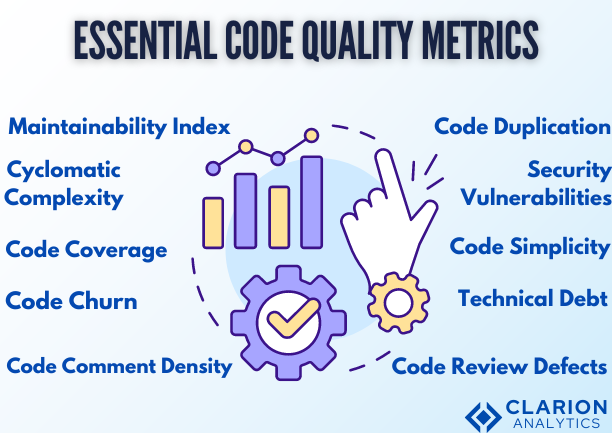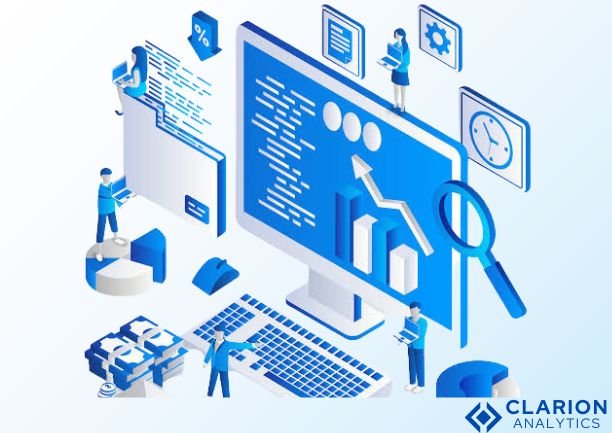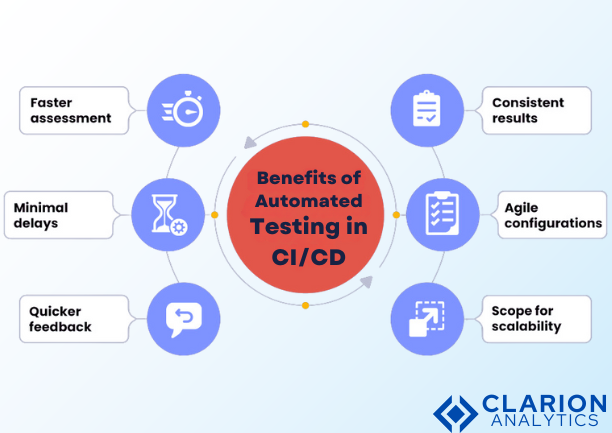
Code quality metrics help in ensuring the success of software projects. The main role is to keep high standards for the product—specifically, throughout the software development workflow—first, from developers to company executives. High-quality code will always be better in maintainability, more secure, and result in better performance in reducing costs and bugs, making the software for that matter more reliable. Given below are ten Essential Code Quality Metrics, that drive up code quality and culminate in successful software projects; these metrics, when understood by a software team, thus, design products well-aligned to business and user satisfaction.
Why Code Quality Matters in Software Development
Code quality is not only a technical problem; it is the very foundation of any software project. Good code behaves better, is easier to work on, and is secure and maintainable. As well, poor code quality can be a reason for performance issues, lower further on, the project’s progress, and increased cost. High-quality code means to developers that they are going to give their work reputation and sustainability. For company executives, this translates into mitigated risks, reduced time to market, and better customer satisfaction. Quality code is a guarantee for software development organizations, not only nowadays but over the long term.
Overview of Code Quality Metrics
We are going to see 10 code quality metrics in this blog: maintainability index, cyclomatic complexity, code coverage, code churn, technical debt, code simplicity, code duplication, code-review defects, security vulnerabilities, and code comment density. Each of these metrics provides a distinctive perspective on evaluating and improving your code base. By tracking these metrics, you can identify areas with potential issues, prioritize actions to reduce technical debt and take further informed decisions to improve the quality of the software.

Metric 1: Maintainability Index
Definition and Importance
The Maintainability Index is a measurement that tells how easy the software will be to maintain and modify. It considers aspects like the size of your code, its complexity, and the level of effort put into understanding its content. A high index means the code is easy to work with, which contributes to keeping the project’s health high in the long run. This is the key factor that’s important for companies because it will make future changes, bug fixing, and implementation of new features cheaper and less effort-intensive.
How to Measure the Maintainability Index
This is most often computed by using the ratio of other metrics, Lines of Code, Cyclomatic Complexity, and Halstead Volume. All these can be computed for your source code using tools like SonarQube, Visual Studio, and Code Climate. The index is always quoted as a number within the interval of 0 to 100, with 100 being the best. To make this metric useful, we must be able to read between these lines.
Improving Maintainability
It is possible to improve the Maintainability Index through code refactoring for lesser complexity, more readability, and nearness to coding standards. This could be done by splitting of huge functions, simplifying complex logic, and organizing code into smaller and easily manageable pieces. Speaking of the consistency of design patterns, the importance of their application and documentation cannot be overstated for maintainability. Regular code reviews and the use of automated tools can highlight areas where improvements in maintainability can be made.
Metric 2: Cyclomatic Complexity
The code quality matrix helps developers maintain high-quality code.
Definition and Importance
Cyclomatic Complexity is a metric that reads the complexity of your code by counting the number of different paths a program might take while executing. In other words, it speaks of how hard code is in terms of being understood, tested, and maintained. High CC only means that the code is likely more problematic in nature—more bug-prone and harder to handle. This is an important metric in maintaining good quality code. Minimizing such complexity is important to keep the code maintainable and scalable.
How to Measure Cyclomatic Complexity
Calculate by counting the number of decision points in your code, such as if statements, loops, and case statements, and then add 1. Tools, such as SonarQube, CodeClimate, or Visual Studio, can automatically calculate this for you. Though the ideal cyclomatic number may vary, generally, values under 10 are considered manageable, and anything higher may be a clue that your code is too complex.
Reducing Cyclomatic Complexity
The secret to cutting down on the Cyclomatic Complexity is by breaking down complex functions into simpler functions that perform small tasks. Besides, design patterns like Strategy or State will clear your logic. Avoid the use of deep, overly nested conditional statements in your functions. It will also decrease after you refactor a large function into smaller ones, each having a specific task alone. Regular reviews of the code and following best practices can drive the results to an acceptable limit for this metric.
Metric 3: Code Coverage
Definition and Importance
It measures the percentage of your code that gets executed during testing. A high code coverage would then mean that most of your code is tested; this is what can be used to ensure that your software is reliable and that potential bugs are caught at an early stage. Code coverage is important in ensuring software quality since untested code tends to contain more defects.
How to Measure Code Coverage
Code Coverage is measured through many tools, including Jest, JaCoCo, and Coverage.py. These tools just go through your test suites to show you which lines of your code were run during testing and which were not. It will usually be shown as a percentage where 100% will be the ideal percentage, though, in practical terms, 80-90% is mostly considered good, depending on how complex the project is.
Maximizing Code Coverage
If you want to maximize coverage, ensure that you write good unit tests that exercise all paths through the code. Besides, have integration and end-to-end testing to ensure that the codes will really work as expected in a practical environment. Automated testing too will ensure the same high coverage. To maintain a high coverage, such reviews and test case updating should take place at regular intervals to accommodate the newly added or refactored code.

Metric 4: Code Churn
Definition and Importance
Code Churn measures how often the code has been changed within a specific time frame. High Code Churn may indicate instability in the code, frequent rewriting, or poor design decisions right from the beginning. It gives an important indication of the stability and reliability of a software project. High churning rates could result in delays, more bugs, and higher maintenance costs; thus, this indicator is very critical to monitor.
How to Measure Code Churn
Code Churn can be measured by keeping track of the number of lines of code that are added, modified, or deleted in each commit or during some period. Tools like Git, Bitbucket, or GitHub can show churn by giving commit history and changes. This data can help to identify areas with high churn so that teams can start figuring out what’s causing it.
Managing Code Churn
Design and Planning Phases: Code Churn may be reduced and managed by improving the design and planning phases of your development process. Encourage in-depth code reviews and make sure that all changes are well thought out prior to their implementation. Likewise, refactoring the code for clarity and organization also helps reduce churn. Besides, Agile practices such as CI/CD facilitate managing churn through small changes.
Metric 5: Technical Debt
Definition and Importance
Technical debt is the result of opting for a quick solution that might not be the best one but is easier and faster to implement, rather than opting for a better solution that takes more time. If you don’t control it, technical debt will pile up in the long run and make your software difficult to maintain, scale, and perform. Keeping your project healthy requires you to monitor and manage your technical debt. Otherwise, overlooking technical debt could increase costs connected with its amortization and result in postponement.
How to Measure Technical Debt
Technical Debt can be measured both in numbers and by the quality of the code. Estimating the effort needed to fix the issues is a quantitative measure. Such estimation can be done with the use of tools like SonarQube and CAST. On the other hand, qualitative measures look at the complexity of the code, the use of outdated technologies, or how often workarounds are in place. These two types of measures provide you with valuable insight into the size of Technical Debt in your project.
Strategies to Reduce Technical Debt
Technical debt reduction is proactive, as code is regularly refactored based on coding standards, and the debt is prioritized within project management. That could also be handled by including automatic testing with Continuous Integration to spot issues quickly before they become huge debts. Another approach to reducing its impact over time is the need to foster a culture of quality and ensure that technical debt is addressed within sprint planning.
Metric 6: Code Simplicity
Definition and Importance
Code Simplicity refers to how easy and simple your code is to understand. Simple code is easier to maintain, debug, and extend; hence, quite important for its long-term success. Complex code is error-prone, and difficult, and slows down the onboarding of new developers into the working of the code.
How to Measure Code Simplicity
One way to measure code simplicity is through its readability and clarity. Tools such as CodeClimate and SonarQube are able to give one metric on code complexity and readability. Secondly, having other developers look over your code is always a good idea in determining if it’s easy to understand.
Ensuring Code Simplicity
Keep your code simple by using names that clearly describe their content or functions that are small and focused; employ uniformity in coding standards. This will avoid unnecessary complications in the code, shunning unjustified layers of abstraction. Regular refactoring and reviewing the code will help to keep it as simple as possible.

Metric 7: Code Duplication
Definition and Importance
Code Duplication refers to instances where either the same or very similar code exists in more than one place within a codebase. This could make the code a little convenient but assuredly increase bugs, make maintenance a little more difficult, and have inconsistencies. Less duplication is essential for maintaining a clean, efficient, and manageable code base.
How to Measure Code Duplication
Tools like SonarQube, PMD, and FindBugs can also be used to measure Code Duplication. All of them analyze the code for duplicate blocks. They provide reports with duplicated code highlighted and the amount existing within the project. By keeping an eye on these reports, a team will be in a position to spot and fix duplication early.
Eliminating Code Duplication
And finally, don’t forget about code duplication: DRY—Don’t Repeat Yourself. Push towards practices that attempt to reuse code rather than duplicate it. Turn duplicated code into functions or classes so that it can easily be reused in any part of the codebase. Moreover, encourages thinking at the time of designing new code for reusing to prevent such duplication beforehand.
Metric 8: Code Review Defects
Definition and Importance
Code Review Defects are issues and bugs found in the code review process. It is important to track them because they are the indicators of the quality of the code that is written and the effectiveness of the review process. The early detection of such defects prevents their induction into production, thereby cutting back on the bugs and improving the code quality.
How to Track and Measure Code Review Defects
Defects can be tracked in your code reviews by documenting all the issues you encounter during reviews and categorizing them by priority, type, and frequency. Tools like Crucible, GitHub, and Bitbucket have features that enable the tracking of code review comments and associated defects. Analyzing such defects gives an improved way to review processes and helps see issues repeating in a codebase.
Improving Code Review Processes
To improve Code Review Processes, set clear guidelines for reviewers, ensure thorough reviews, and encourage multiple reviewers for critical code changes. Focus on preventing defects by educating developers on common mistakes and best practices. Regularly update the review process based on feedback and trends in defects to make it more effective.
Metric 9: Security Vulnerabilities
Definition and Importance
Security vulnerabilities in one’s code can actually also lead to quite severe consequences, like data breaches, unauthorized access, and even service disruption. These vulnerabilities will need to be discovered and eliminated in the early stage of development in order for the software to be safe for its potential users. Security concerns are to be paramount in software development to ensure that it has the best chance possible of being resistant to attack.
How to Measure and Monitor Security Vulnerabilities
Security vulnerabilities can be measured and monitored using such tools as OWASP ZAP, SonarQube, and Snyk, which scan the code for common security issues including SQL injection, cross-site scripting, and insecure dependencies. These tools provide detailed reports on identified vulnerabilities with suggestions for fixing them. Periodic security audits and penetration testing can also locate vulnerabilities that automated tools may have failed to audit.
Enhancing Security Practices
Insert security throughout the entire software development life cycle to make it more effective: embed security in the whole of the software development life cycle. Implement secure coding standards, provide frequent security training and awareness to developers, and have a quick process of fixing vulnerabilities. CI/CD pipelines with automated security scans will help detect and remediate vulnerabilities in the early stages
Metric 10: Code Comment Density
Definition and Importance
Code Comment Density is a good measure of your comments relative to the total lines of code. Comments help make your code easily readable and maintainable, especially in large or complex projects. Still, you have to strike a balance: too few comments can make your code hard to understand, while too many can clutter the codebase.
How to Measure Code Comment Density
Code Comment Density can be measured using tools such as SonarQube and CodeClimate, which analyze your codebase and provide metrics on the number of comments to the total number of lines. The tools scan the codebase for the following merits to ascertain there is enough comment content without unnecessary details that overload the codebase:.
Balancing Comment Density with Code Clarity
In the pursuit of balance between Comment Density and Code Clarity, write meaningful comments clarifying the intent behind the code and not just the patently obvious. Attempt for self-describing code upon which minimal commenting is needed while needing comments for clarification in particularly detailed or non-intuitive parts. Regular code reviews will ensure comments help to effectively get a codebase clear and maintainable.
The Role of Automated Tools in Tracking Code Quality

It is absolutely infeasible to imagine tracking and analyzing quality code metrics without automated tools, such as SonarQube, CodeClimate, or Jenkins, being embedded in the development workflow and giving continuous feedback on quality. The tools do the measuring of the metrics themselves and, therefore, remove the burden from the teams of doing so and facilitate management by freeing up time to spend on writing and improving code. Integrating them into the development pipeline keeps the team’s code quality top-notch across the software development lifecycle.
Integrating Code Quality Metrics into CI/CD Pipelines
Ensuring the quality of code in development and production requires the integration of code quality metrics into CI/CD pipelines. This ensures that teams detect issues early enough for fixes to be made by automating the measurements of metrics like Code Coverage, Cyclomatic Complexity, and Security Vulnerabilities within a CI/CD pipeline. In this respect, this integration will assure the deployment of high-quality code and reduce potential risks of defects, improving the general stability and performance of a software system.
Conclusion: The Path to Software Success
Monitoring and improving code quality metrics is very important for the long-term success of your software. With metrics like the Maintainability Index, Cyclomatic Complexity, and Code Coverage at your disposal, you will be well on your way to checking if your codebase is maintainable, scalable, and secure. The strategies and tools outlined in this blog will empower your team to deliver high-quality software that meets business objectives and user expectations. Code quality is not just about reducing bugs or speeding up the development period; more than that, it’s building a strong base for sustainable and successful software projects.
Intrigued by the possibilities of AI? Let’s chat! We’d love to answer your questions and show you how AI can transform your industry. Contact Us
